In this module, you will learn how to empower students in learning by building an ePortfolio with Canvas Folio (Portfolium) to document, reflect on their learning experiences, and connect with other professionals.
What Is ePortfolio?
You delivered the lectures, engaged students with some discussions, and gave them some real-world problems to work on. You also administered some quizzes and the final exam. What's next? How can you instill deeper learning? How can you help them to connect the dots and see the bigger picture?
To answer the questions above, let's first take a look at ePortfolios.
An ePortfolio is a personal website. But it is not just a website. In the academic context, an ePortfolio is a digital or online collection of students’ coursework, such as essays, posters, technical papers, videos, and audio productions. It can also include the student’s employment and volunteer history, club activities, and more. A good student ePortfolio should not only document learning but also generate learning.
Many programs at Georgia Tech have traditions to use electronic portfolios for various purposes, such as student work showcase, competition, undergraduate admissions, and graduate program admission.
WCP @ Literature, Media and Communication
The Writing Communication Program (WCP) at the School of Literature, Media, and Communication (LMC) uses ePortfolios to integrate reflection to each stage of student writing at ENGL 1101/2 and assess the program's outcomes.

School of Architecture @ College of Design
School of Architecture at the College of Design hosts a Portfolio Competition and Celebration to showcase end-of-fall-semester works for students at different stages.

School of Industrial Design @ College of Design
School of Industrial Design has students showcase their works via portfolios with their own choice of platforms.

Why ePortfolios?
Research shows many benefits of using ePortfolios to engage students in learning, such as:
Engaging students in knowledge construction with the social context (Lewis, 2017; Rico, 2017)
Allowing students to own the process (Fuller, 2017)
Motivating students to create evidence for future career advancement (Perks & Galantino, 2013)
We will discuss each aspect next.
Engage Students in Knowledge Construction with the Social Context
The process of building an ePorfolio itself is a process for a learner to construct learning. This process falls under a learning theory called Social Constructivism (Amineh & Asl, 2015). Social constructivism is a process where learners construct their knowledge through interaction with the learning materials, learning environment, and people compared to the traditional instructor-centered, lecture-based learning style.
The graphic below shows how students construct their knowledge by interacting with the artifacts and others, during the process of making an ePortfolio. Note that these six elements may happen simultaneously and may not follow the order shown in the graphic.
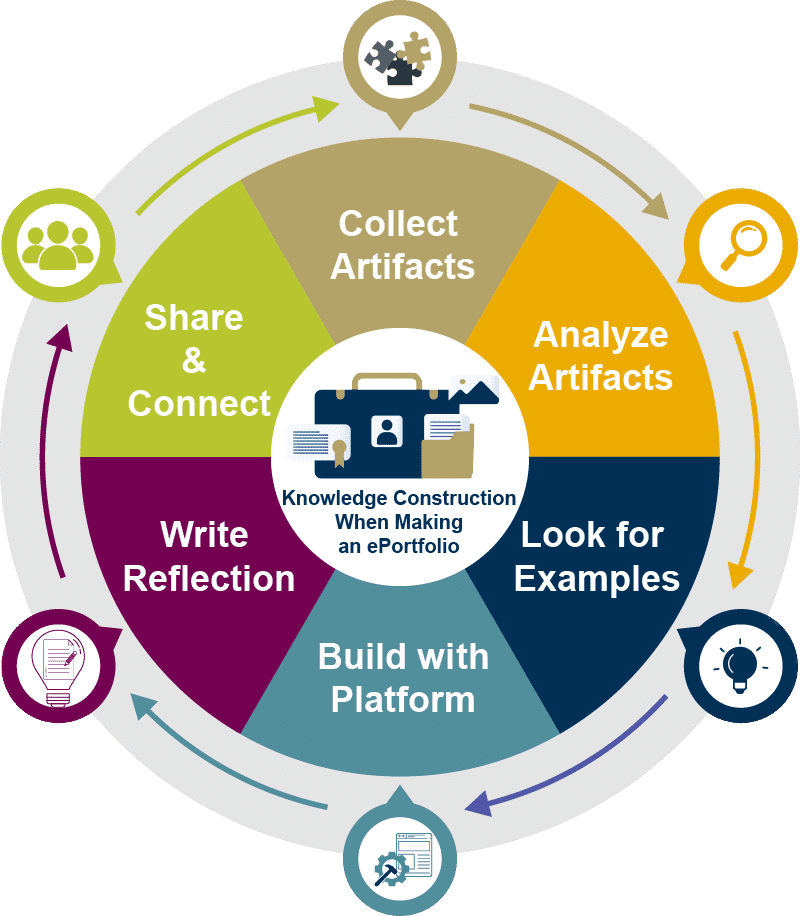
Engaging Students by Letting them Own the Process
Students building and owning the ePortfolio means that they are in control, and they are more likely to engage in the learning process actively. Research shows that students are more engaged when they have choices in learning (Tosha, Penny Light, Fleming, Haywood, 2005). Students are to use ePortfolios to map out their learning and career path because:
…the very process of developing an ePortfolio prompts students to adopt future-oriented thinking.
(Bennett, Rowley, Dunbar-Hall, Hitchcock, & Blom, 2016)
Motivating students to create evidence of learning for future career advancement
In addition, many students may plan to use their ePortfolios for their job searches, funding, and graduate school program applications. With a future application goal in mind, students are more motivated to create artifacts and pieces of evidence to highlight their knowledge and skills, problem-solving ability, and leadership.
Are you planning on using ePortfolios in your class or program this fall?
If you are, how can you make sure students get the most out of it? How can you, as an instructor, make sure the implementation of ePortfolios is successful?
In the next section, we will introduce the best practices to implement ePortfolio to engage students in learning.
References:
Amineh, R.J., & Asl, H.D. (2015). Review of Constructivism and Social Constructivism. Journal of Social Sciences, Literature, and Languages, 1, 9-16.
Bennett, D., Rowley, J., Dunbar-Hall, P., Hitchcock, M., & Blom, D. (2016). Electronic portfolios and learner identity: An ePortfolio case study in music and writing. Journal of Further and Higher Education, 40(1), 107- 124. https://doi.org/10.1080/0309877X.2014.895306
ePortfolios Explained: Theory and Practice. Centre for Teaching Excellence. (2019, March 4). https://uwaterloo.ca/centre-for-teaching-excellence/teaching-resources/teaching-tips/educational-technologies/all/eportfolios.
Fuller, K. (2017). Beyond Reflection: Using ePortfolios for Formative Assessment to Improve Student Engagement in Non-Majors Introductory Science. The American Biology Teacher, 79(6), 442–449. https://doi.org/10.1525/abt.2017.79.6.442
J.M. Perks, & M. Galantino. (2013). The development of an ePortfolio as a capstone in a holistic health minor. International Journal of ePortfolio, 3 (1), pp. 39-46.
Lewis, L. (2017). ePortfolio as pedagogy: Threshold concepts for curriculum design. E-Learning and Digital Media, 14(1-2), 72–85. https://doi.org/10.1177/2042753017694497
Rico, C. (2017). The ePortfolio: constructing learning in translation technology. The Interpreter and Translator Trainer, 11(1), 79-95. https://doi.org/10.1080/1750399X.2017.1306995
Tosh, D., Penny Light, T., Fleming, K., & Haywood, J. (2005). Engagement with electronic portfolios: Challenges from the student perspective. Canadian Journal of Learning and Technology, 31(3).
Technology for Building an ePortfolio: Folio (Portfolium)
About Folio
Folio is the name for Portfolium in Canvas. Portfolium is an academic portfolio platform combined with social network functionalities, which allow students to document, reflect upon and share their learning process with others and build their professional network.
Folio allows students to create a profile that introduces themselves and include skills, education, courses, certificates, extracurricular activities, etc. Students can then build projects and link them to corresponding skills in the profile. Each project can include multiple pieces of coursework, artifacts, and a description. Students can decide whether to make their entire portfolio or just selected projects visible. They also turn on and off comments for each project. In addition, within Portfolium, students can search for projects, make connections with other professionals, follow companies, and apply for jobs. Lastly, students can connect their Portfolium accounts to other social media accounts, allowing them to quickly sync their Portfolium projects to other platforms and make more connections.
How to Access Folio?
Portfolium is integrated with Canvas and is available under Account as "Folio." The screenshot below (Figure 1) shows where to access Folio after you log into your Canvas account.
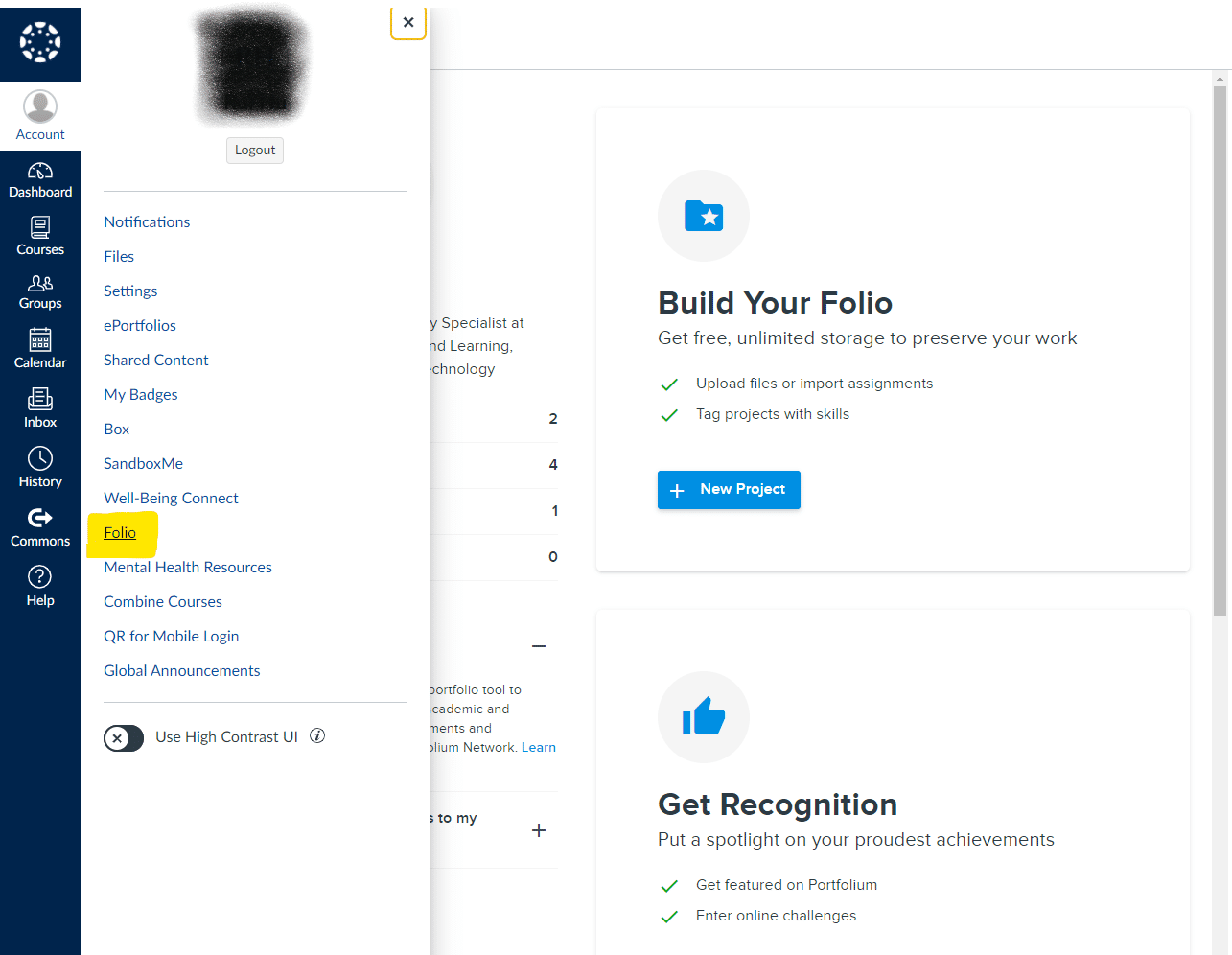
How to Control Folio's Visibility?
There are two places where you can control your portfolio's visibility by changing their privacy settings: your profile and each project. Your profile can be set as open to the public or only allow people that you are connected with to view your profile. In addition, each project's privacy settings at any of the following levels: Public ->Portfolium members-only -> connections only,->only accessible by links.
Note: Changing your profile privacy setting does not change the privacy settings for your projects or vice versa. This means that you can have your profile open to the public while still keep some or all of your projects only visible to yourself or your Portfolium connections. On the other hand, even if your profile is only viewable by connections, you can still share a project with anyone via the project link.
Control the Visibility of Folio Profile
To change the visibility of your profile, open your profile by clicking the "Me" icon in the toolbar, then "Settings -> Privacy," then check or uncheck the boxes as shown below in Figure 2. You can also change other privacy settings and submit a download data request on this page. When you are done with changing privacy settings, click the Update Privacy Settings button.
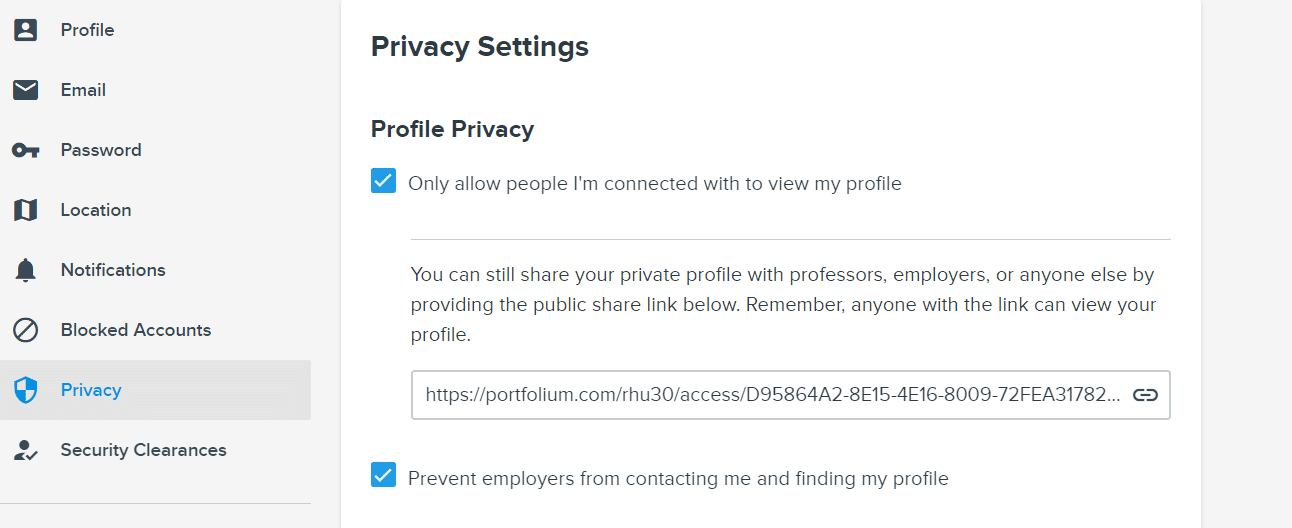
Control the Visibility of Projects
You can control each project's visibility level and manage comments by editing the project's privacy setting.
- Click the Me icon in the toolbar, and then click the View Profile link
- Click the PORTFOLIO tab to open your portfolio.
- Click the Options icon [1] and then click the Edit option [2].
- Click on the Settings button and set project visibility.
- Check the Comments box would allow anyone who can see your project to make comments. If this box is unchecked, no one can leave a comment.
- Don't forget to click the Done button after you finish editing the project settings.
How can you log into Folio with a non-GaTech email address?
Portfolium allows multiple accounts as log-ins. When you log into Folio via Canvas, your Georgia Tech email address is set as your primary email address by default. However, you can add other email addresses as your alternative log-ins. Plus, you can switch to a non-GaTech email address as your primary email. All future Folio notifications, updates, and reminders will go to this new primary email.
Add and Verify New Email Addresses
You can add additional email addresses from Settings -> Email -> Add New Email.

You will need to verify the newly added email address before you can use it to log in.
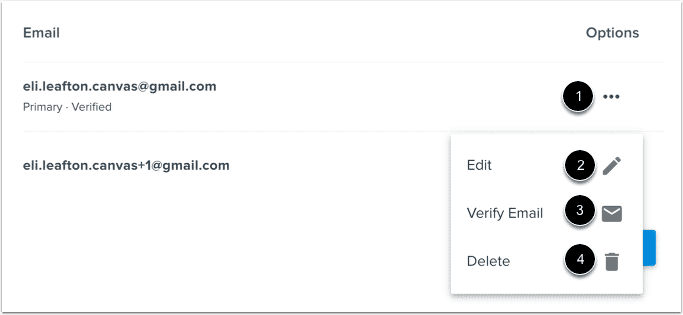
Update Your Non-GaTech Email as the Primary Email
Once you have the new email address added and verified, you will need to log in to Folio via Canvas shortly before leaving Georgia Tech and making your non-Gatech email address your primary email.
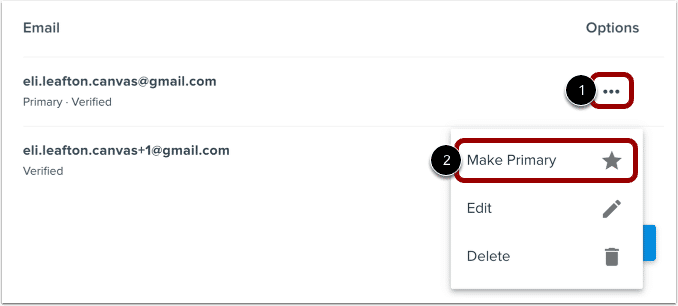
Other Tools Available for Georgia Tech Students
Some other tools that are available for Georgia Tech students to build an ePortfolio include but not limited to Adobe Portfolio, Adobe Spark, and Georgia Tech GitHub Pages. Read this blogpost to know more about them.
What Can You Do with Folio?
Folio can be used in various ways to engage students with social, reflective, authentic, and active learning experiences.
Build an academic and professional identity: Folio is a portfolio platform with social network functionalities. Ask students to create their Folio profiles and link to their projects. Their Folio profiles then become their social media presence, which can be used to connect with their instructors, peers, and professionals within and outside of Georgia Tech.
Provide ongoing feedback for reflective learning: You can ask students to upload their ongoing coursework for several iterations to Folio for you to give continuous feedback. Each iteration should show improvements based on students' reflections and a new understanding of the topic. By the end of the project, students will have a well-documented project showcasing their growth in learning for future reflection.
Tie to Canvas assignment for active learning: Projects created in Folio can be submitted as a Canvas course assignment. Create authentic tasks for students to work on. Then ask students to showcase their products in Folio and submit it as a Canvas course assignment. By actively creating, collecting, and selecting artifacts to showcase their learning, students take ownership of their learning and the assessment process with the instructor's guidance.
Build Academic and Professional Identity for Connected Learning
Students can build their academic and professional identity, start with creating their profile. They can then share their profiles and stories and connect with others.
This video below demonstrates what can be included in their Folio profile.
In summary, here are how students can build their academic and professional identity and connect with others.
- Edit the overview information for the profile
The Overview section of your profile provides people who view your profile a quick summary of your basic information, including your name, tagline, education, current position, and location. You can edit your profile overview by clicking the Edit button on the Portfolium home page. You will be able to update your profile and cover photo, name, tagline, education, current position, and location.
You will also see the Profile Strength Meter on the right side of the homepage. As you add items to your profile, the Profile Strength Meter will update accordingly to remind you of tasks remaining to complete the profile. A blue checkmark means that you have completed this task [1]. A grey one [2] means you still need to work on that. Click the See More [3] button to see the hidden tasks.
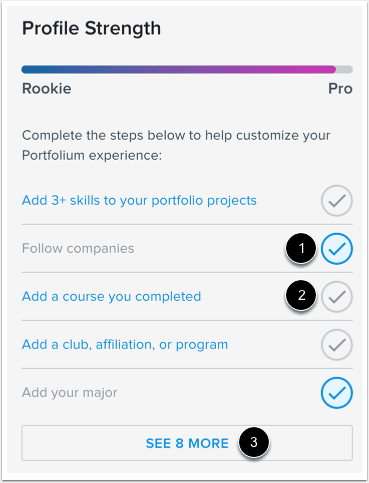
- Add an introduction
You can add a brief introduction to tell your connections or potential employers about you, your educational background, and your professional experiences. To add an introduction, click on the Me icon, then choose View Profile. You will then see the prompt of Add Introduction. Click to edit the introduction. Type in texts under "Edit Details." To add hyperlinks in the texts, use markdown formatting.
For the Introduction section and all other sections in your profile, you can add projects by either choosing from your existing projects [1] or Add new project [2]. When adding multiple projects, you can adjust the order they display by selecting the Arrange order toggle [3].
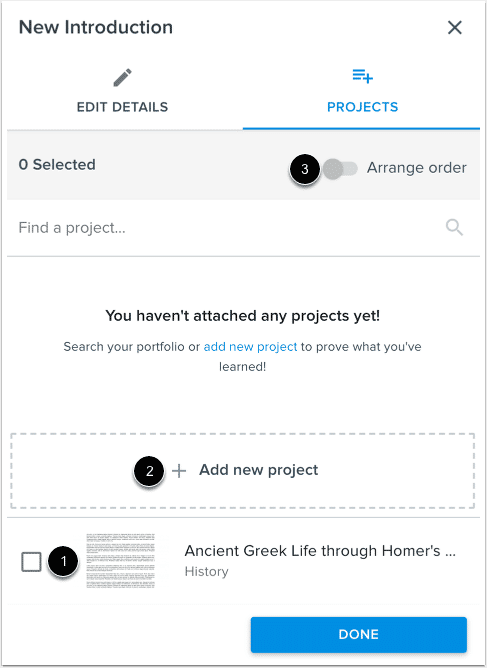
- Add courses, work experience, skills, certifications, etc.
You can add multiple entries for each of the following sections in your profile:
- Courses
- Education experience
- Work experience
- Skills
- Certifications
- Publications
- Badges
- Accomplishments
- Clubs, affiliations, and programs
- Athletics
- And volunteer work
For each section, you can:
- Add an image
- Enter details such as title, description, and date
- Attach projects
You can also move each section up or down by clicking the Up or Down Arrow next to the section title.

- Upload resume
You can upload your resume either from your device [1] or your linked social media platforms [2]. To do that, click on the Me icon, then choose View Profile. In the resume section, click the Upload icon.
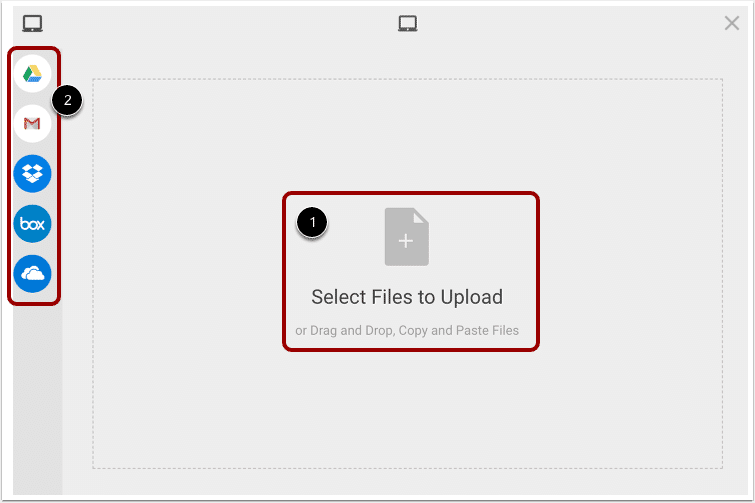
- Connect to social media or other applications
Connecting an application allows the user to import content directly from your other accounts. It also allows the user to quickly sync their projects to other social media platforms. To do so, click the Me icon, then clicking the Settings link. At the bottom of the Settings menu, click Connected Apps. You will see a list of available apps for you to connect. Under each app, you will see what you can do after connecting with the app.
Click the CONNECT link to connect an app. Depending on the app, you may need to enter your login credentials.
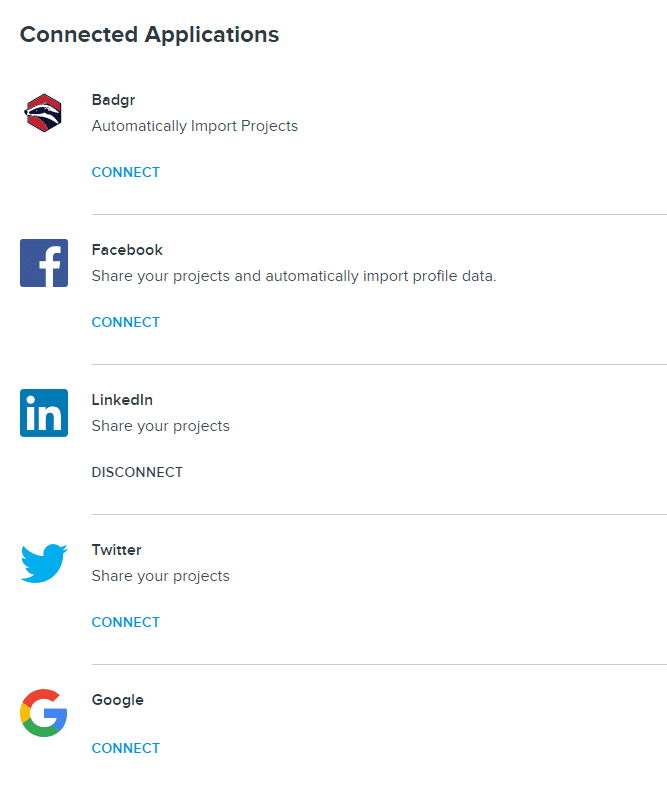
- Connect with others
There are many ways to connect with other professionals. When you are viewing a project, you can send a connection request by clicking on the CONNECT button on the right side of the project. You can also find connections by searching their names using the Search box [1] on the top left of a page and filter results by People [2]

- Add security clearances
You can add your security clearances to allow employers that require specific clearances to find your portfolio. To do that, go to Settings under the Me icon, click Security Clearances. Check all security clearances that apply.
Note: Only select security clearances that you have and are current. Lying about security clearances is a federal crime.
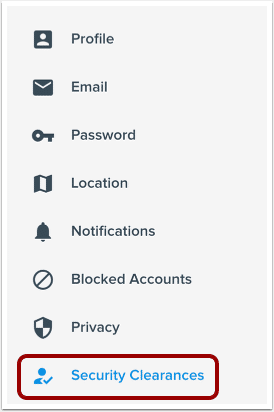
- Download profile as PDF
You can download your profile as a PDF file. You can choose projects to include in the downloaded file. Each project will have a URL in the PDF for its reader to click on. This can become handy if you want to send as a supplemental material to a potential employer, etc.
To download your profile, click the Me button, then View Profile. Click on SAVE AS PDF, then choose if you want to save a one page summary, or a resume based on your entire profile.
Provide ongoing feedback for reflective learning
Students can upload their coursework and write reflections in iterations to a Folio project for the instructor's continuous feedback. In each iteration, students read the instructor's feedback, make changes to the coursework, write a new reflection, and then upload them for new feedback. Each iteration is an improvement to the previous version. In this process, students continuously revisit their learning and connect fragments of information to a whole piece. By the end of the project, students have a well-documented project showcasing their growth in the course.
- Add a new project
Projects are a great way to showcase work students have completed for their course or program. Project types include research and lab reports, essays, and demonstrations of design, drawing, and writing skills.
As you add content to a project, the project strength meter will update to show how strong the project is. 26 points are possible, and points are awarded as follows:
- Title: 1 point
- Attachments: 3 points each, up to 4 attachments
- Category: 2 points
- Description: 2 points
- Skills: 1 point each, up to 5 skills
- Teammates: 0.5 points each, up to 2 teammates
- Tags: 0.5 points each, up to 4 tags
- Cover: 1 point
You can add a new project in three ways:
1. Click on Folio on your Canvas Account page. Then click on + New Project.
2. Open your profile, click the Me icon in the toolbar, and then click the View Profile link. Then click on Add new project.
3. Import a Canvas Assignment into a Folio project.
After adding a new project, you can then start adding contents to it.
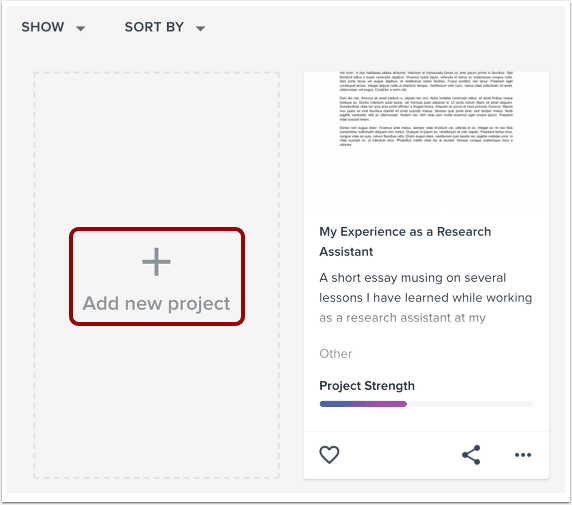
Import an Assignment from Canvas in Folio as a New Project
If students have connected their Canvas account, they can import assignments directly from Canvas. Note: Each course assignment will appear as a separate project in students' portfolios.
To do that, click the Me icon on the upper right of any page, then click the Settings link. Next, click the Import Data link. If students have already connected Canvas to their Folio account, they will be able to select the Canvas icon under "Select a provider" and click CONTINUE. Students will then be prompted to choose course assignments to import.
- Each course assignment may include multiple files, and you can import multiple course assignments simultaneously.
- Each course assignment can only be imported once. Students need to make sure the course assignment that they are importing is the final version.

Add a cover photo to the project
You can add photos to your projects to help showcase your work. Photos can be uploaded from your device, imported from linked social media accounts, or imported from a web search.
For best results, default images, or thumbnails should be 500px by 280px.
To upload a photo saved on your device, click the Upload files link after you enter the edit project page, and select the file.
To import a photo from a linked social media account, such as Facebook or Instagram, or search the web for a photo, click the More options link.
In the Edit window, you can edit the photo's title [1], caption [2], and alt text [3]. To use the photo as the cover photo for your project, select the Use as cover photo checkbox [4].
When you have made all your edits, click the Done button [5] to save your changes.
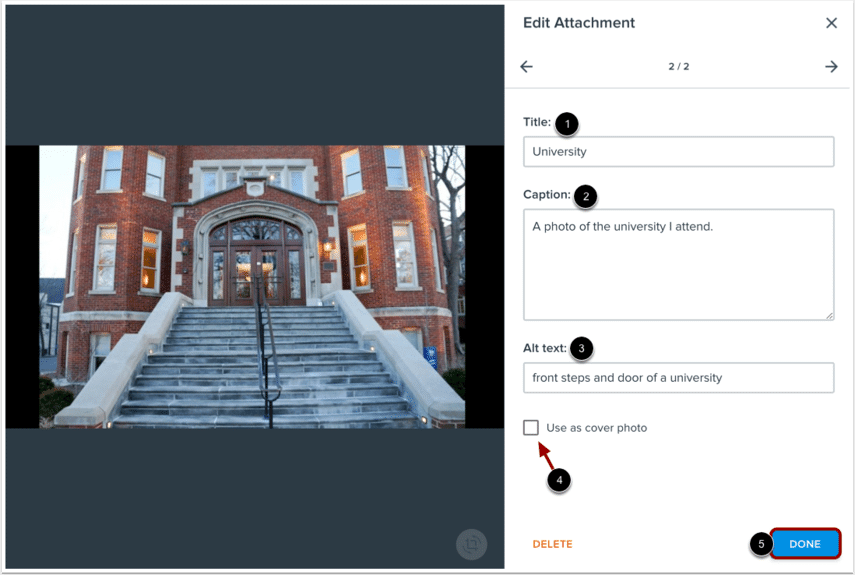
Adding content to a project
After adding a new project, you can add content to it, starting by adding a name.
You will then upload attachments or embed media. You can also import files from Google Drive, Dropbox, etc. To see Folio-supported file types, see here. For each file and link added, you will be able to give a title and add captions. If the file is an image, you can also add ALT text and set it as a cover photo.
Note: Captions added to a file will be viewable when the user clicks on the "i" icon on the lower right corner under the file.
You will want to add a category in the Category field to help other Folio users to find your project more easily. You can see the list of all available categories here.
In the Description field, add a brief overview of your project and reflect on how you created the project.
You can also add skills, tools, or software to your project, which will automatically be synced to your profile.
You can also tag your teammates by typing their names in the Tag Teammates field and choosing their names.
You can also add tags to help other Folio users filter search results and find your project more easily.
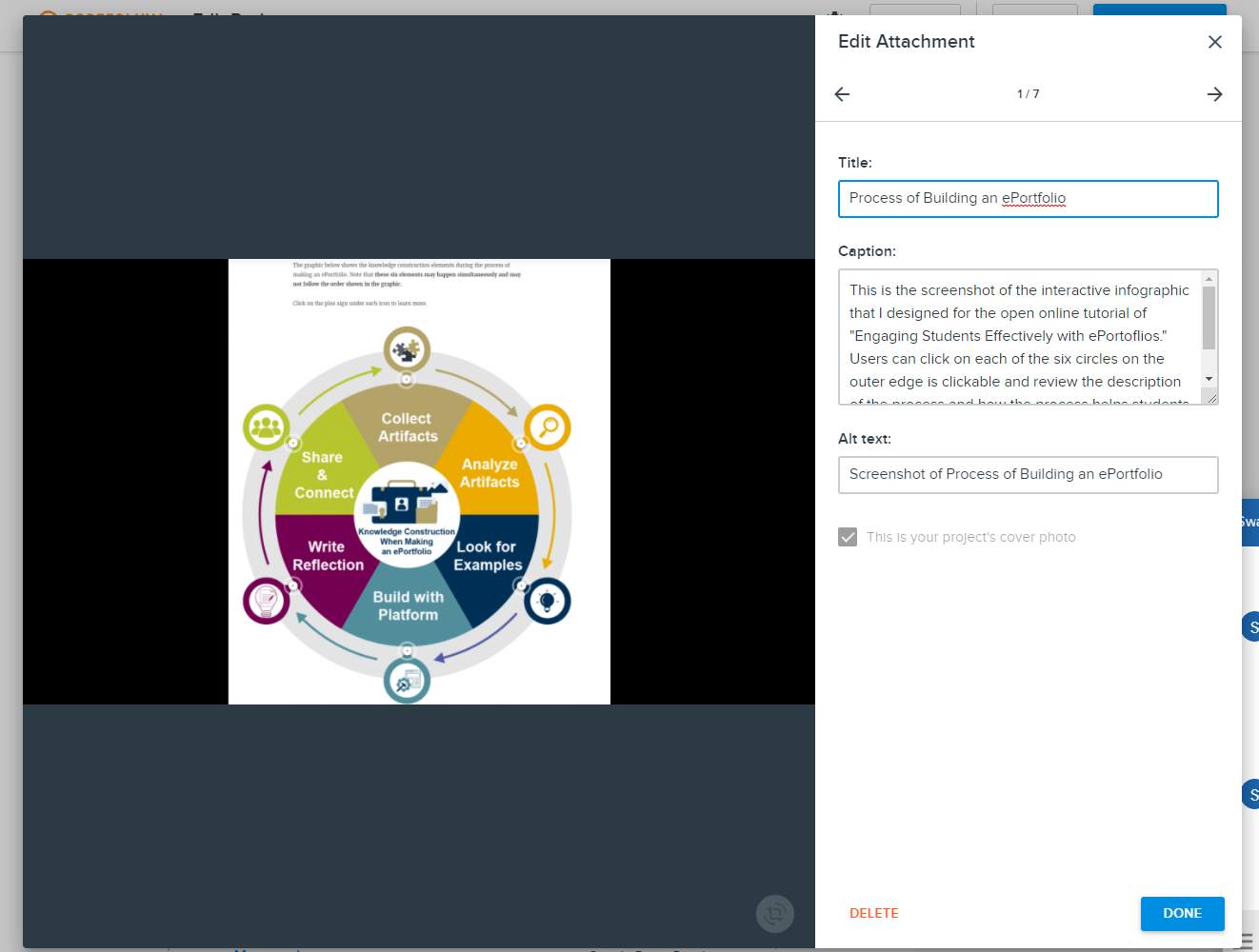
Share a project for feedback
You can share your projects with others via one of the three following approaches:
- Posting to a linked social media account
- Sending the direct URL
- Embedding to another website
To do share a project of yours, open your profile by clicking the Me icon, then the VIew Profile link. Click the PORTFOLIO link to choose the project you want to share. Click the Share icon, you will see the three options to share: to a linked social media account, via a project URL, and embedding to another website.
You also share someone else's project by clicking the Share icon on the project page, then you will see the same three options to share.
Note: As mentioned in the previous lesson, the project owner can adjust a project's setting to control its visibility to the public, Folio (Portfolium) members, connections, and private. Users can also decide if they want others to comment on the project or not.
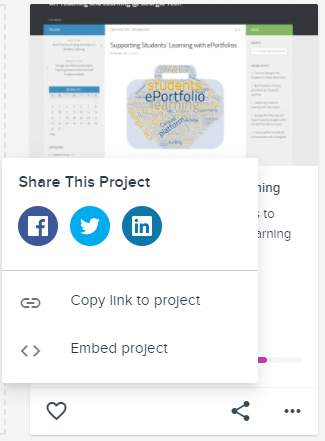
Leave a comment to a project
You can leave a comment on a project if it is set to allow comments. To leave a comment, type at the bottom of the project page.
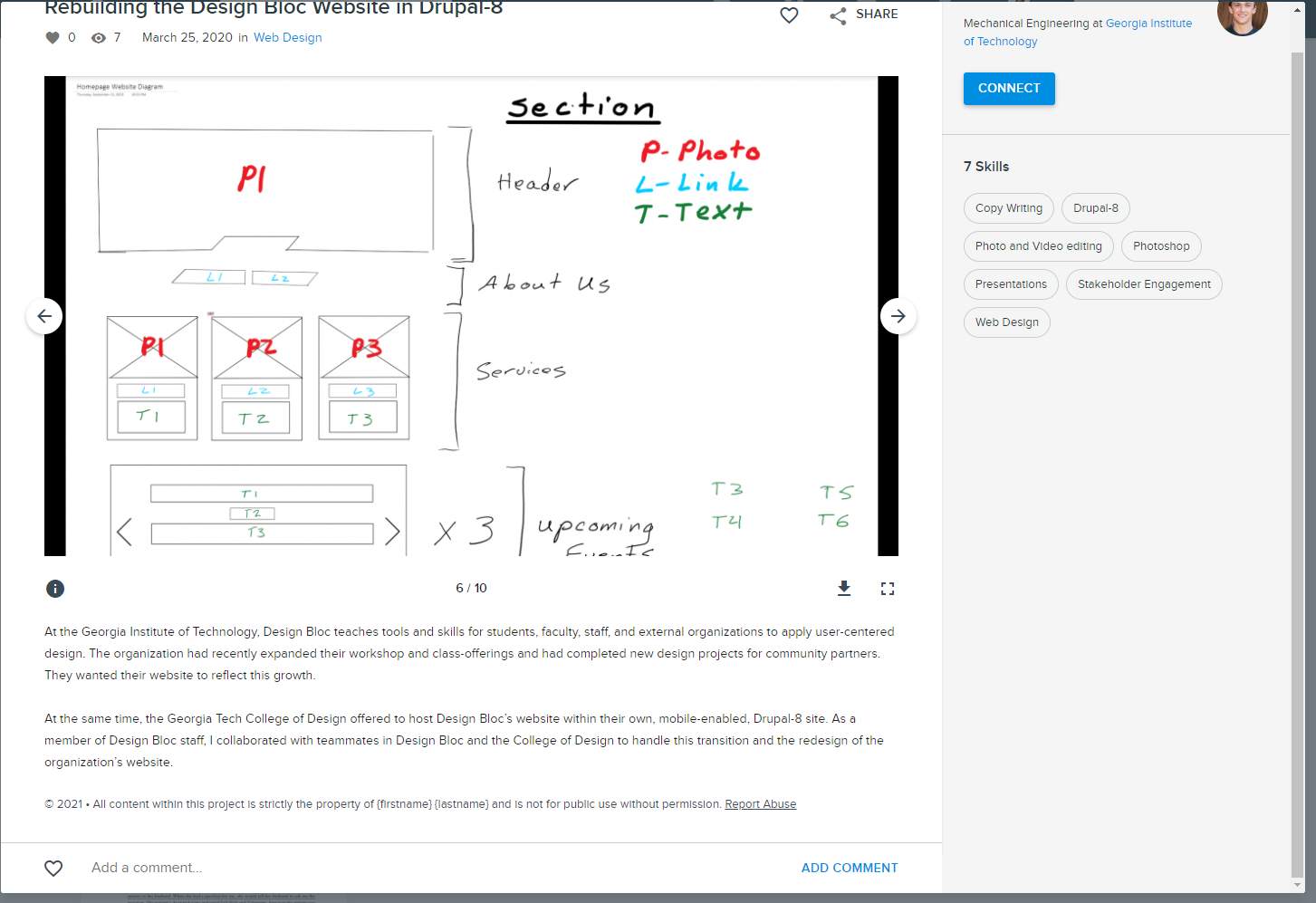
Tie to Canvas assignment for active learning
Creating projects in Folio gives students the chance to take ownership of the learning by actively creating, collecting, selecting, and reflecting on their course works. You can create a Canvas assignment to ask students to create a product or several products. You need to guide students through this process with carefully crafted assignment instruction, including required elements in the project, requirements for the reflection, a rubric, and some example Folio projects.
Step 1: Create a Canvas Assignment
Create an Assignment in your Canvas course. The submission type should be online -> URL Submission. If you are asking students to create a Folio profile, ask them to submit their profile URL. If you are asking students to create a project in Folio, ask them to submit the direct URL to their project.
The instructor needs to explain the purpose of the assignment to the students, tell the students what they need to do, and what to include in the project, and provide a carefully designed rubric. Ideally, the instructor would also provide some existing profiles and projects as examples.
Below are two Canvas + Folio Assignments for you to import from Canvas Commons and use in your own Canvas course:
- Canvas + Folio Assignment: Create Your Folio Profile
- Canvas + Folio Assignment: Create a Folio Project
Step 2: Grade the Assignment in Canvas
You can grade student's submitted Folio projects directly within Canvas from Speedgrader. Click on the URL link to display the Project in the SpeedGrader window. If students update their projects after submission, the changes will be reflected in the project. They do not need to re-submit.
When to use it?
- At the beginning of the semester - You create a Folio assignment in Canvas to ask the students to create their Folio profile and submit the link. Students add basic information to their profiles and connect to their classmates. You grade the assignment. Meanwhile, students keep working on their Folio by displaying and reflecting upon their learning.
- At the beginning of a course project - You create a Folio assignment in Canvas at the beginning of a course project and ask students to submit the link to a project created in Folio. Students will then keep adding artifacts, written paper, lab reports to the project and write a reflection. You grade the assignment once the project is due.
- At the end of the course or program as Capstone - You create a Folio assignment in Canvas and ask students to submit the link to a project created in Folio. Students will then collect all artifacts created during the course or program, to demonstrate their skills and knowledge learned in the course or program. They will also write a reflection on their learning experiences
When You Might Not Use it?
- Situation:
- You want to build significant class discussion and peer learning around the work immediately.
- Students will never need their work again
- Work has no connection to students' future course
- There might be a significant amount of weak, ongoing, and unpolished work
- To ease students' concern about sharing sensitive information
- Alternative Approach:
- Online discussion in Canvas
- Regular assignment in Canvas
- Regular assignment in Canvas
- Use another type of Canvas assignment now. Then have the students submit a Folio project at the end of the semester when the products are completed.
- Regular Canvas assignments are only viewable by the instructors.
Strategies for Using Folio Effectively
ePortfolios work the best when they are implemented program-wide or institution-wide. But they can still be at a smaller scope, such as for capstone projects, multi-semester classes, cross-discipline classes. Below are some best practices to implement ePortfolios.
- Explain the benefits of ePortfolios to students
ePortfolios can help students achieve a deeper understanding of the subject area and reflect on their learning journey. Students can use it as the online presence of their academic and career achievements. ePortfolios can also help students connect with other people and be a great tool to highlight their skillsets, abilities, and potentials for job searching and graduate program applications.
- Establish clear expectations
Like all other assignments, you will need to explain what you expect from the students for their ePortfolios. How many artifacts should students include in their ePortfolios? In what format? Do you expect them to write reflective paragraphs for each artifact or just one reflection piece for the entire portfolio? If they need to write reflective paragraphs, how long should they be? How should they make connections between various parts of artifacts and experiences?
- Select the right ePortfolio platform
There are many platforms to build student ePortfolios, including a few available at Georgia Tech, and this article will introduce later. Each platform has its features and may be suitable for different ePortfolio needs. For example, some are good for showing teamwork; some are good for highlighting computer programming skills and data analysis abilities; some are designed to present artistic works, such as graphics, photos, audios, videos, and animations. The instructor needs to analyze the nature of the ePortfolio and find the “right” platform.
- Review the platform and examples with your students
Walking through the processes of adding artifacts and other features of the ePortfolio platform can reduce the time, and energy students spend on figuring on the technology. Besides, showing students examples of other students’ ePortfolios will help them find their ePortfolio strategies, such as design, organization, design, and connections.
- Build your own ePortfolio
The best way to teach is to use your own experiences as an example. Building your own ePortfolio will prove to the students the benefits of doing it. You will also better understand the process, challenges, and advantages, which helps you lay out the instruction and assessment for the ePortfolio assignment.
- Tie ePortfolios to assessment
Building an ePortfolio can be very time-consuming. Therefore, it should be tied to the final grade and should take a significant portion. Also, the standards to assess the ePortfolios should be clear and concrete. We strongly recommend using a rubric to assess ePortfolios. Here are some excellent examples of rubrics for evaluating ePortfolios:
Common Feedback Chart by Writing and Communication Program at Georgia Tech
- Make it social
As a tool that supports students learning via social constructivism, an important aspect of ePortfolios is sharing with others, making connections, and receiving feedback. You could have a page in Canvas including links to all students’ ePortfolios. You could then add a discussion forum to make it easy for students to comment on each other’s ePortfolios. Some ePortfolio platforms also allow students to “connect” with others within the same platform and export their ePortfolios to other social network websites (i.e., LinkedIn), such as the Portfolium platform we are going to talk about next.
Recommended Resources
Resources
Portfolium Guides: Portfolium Guides provides official documentation on all features and functionalities of Portfolium, including setting up profile and visibility, building a project, connecting with others, and mobile features.
Portfolium Course on Canvas: This course introduces all features of Portfolium and is open to the public.
Massive Open Online Course by Georgia Tech: Build Your Professional ePortfolio in English
A knowledge article on Folio @ Georgia Tech
Support
You can get support by chatting with Portfolium support from any page in Portfolium. You can also view the Portfolium User Group to search for an answer to your question.